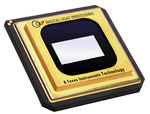Sharp XV-Z9000U 16:9 dlp projector HD1 Chip Set
"What have you done to make it look so good?"
That's what I asked Adam Kunzman, manager of home portable entertainment products for Texas Instruments' DLP Products division. As the first projector based on TI's much-anticipated HD1 DMD (Digital Micromirror Device) chip, the SharpVision XV-Z9000U displayed an image that bore a strong family resemblance to other HD1-based projectors I've previewed: lots of detail, solid blacks, and good color fidelity. I wanted to know if the '9000's knock-your-socks-off image was more a result of TI's new chip, or of Sharp's electronics and optics.
 Last August, Texas Instruments announced this new version of the DMD, the semiconductor chip at the heart of the Digital Light Processing technology. The HD1 DMD is a version of the previously released HD1 (featured in DLP rear-projection sets from Mitsubishi, Panasonic, and Hitachi), but the new chip is optimized for front projectors.
Last August, Texas Instruments announced this new version of the DMD, the semiconductor chip at the heart of the Digital Light Processing technology. The HD1 DMD is a version of the previously released HD1 (featured in DLP rear-projection sets from Mitsubishi, Panasonic, and Hitachi), but the new chip is optimized for front projectors.
The HD1 features a 16:9-aspect-ratio array of 1280x720 pixels, which allows it to deliver native support for 720-line progressive-scan high-definition programming. The higher resolution of the new device offers improved sharpness for all picture formats and sources, including HDTV and DVD. Graphics applications, such as PC games, are also a good match for the new chip. According to TI, the HD1 provides a best-of-all-worlds solution, with outstanding video and exceptional graphics performance.
The HD1 benefits from a new production process that places a dark metal substrate under the chip's 921,600 mirrors. The substrate absorbs stray light better, providing darker blacks and enabling the XV-Z9000U to achieve, according to Sharp, a contrast ratio of 1,100:1.
"Our high-definition DLP display technology simply provides the best contrast and image quality available today," Kunzman enthused. "Advances in DLP electronicsincluding faster operation of the DMDhave virtually eliminated color-separation artifacts, enabling projectors based on DLP technology to deliver image quality that is unsurpassed." But TI can't take all the credit for the '9000's image quality, according to Kunzman. "Sharp's engineers have done a great job on the electronics and optics in the new projector. We're very pleased at the result they've achieved with the XV-Z9000U."
I asked what we can expect in future DMD devices, as two new versions of the HD1 are already rumored: the HD-2, similar to the HD1 but with mirrors that tilt farther to enable even better blacks; and what to me is the Holy Graila 1920x1080-pixel DMD.
"Customer feedback has shown that the areas of improvement people are most interested in are black levels, contrast ratio, and color fidelity," Kunzman replied. "Those are the areas we're looking to continually improve upon, and the HD-2 will aim for increased performance in those areas." He said that several manufacturers have expressed interest in producing a three-chip DLP projector based on the HD1, which could potentially offer the HD1's benefits of resolution and black level while providing much higher light output.
And my Holy Grail . . . ?
"A 1920x1080 DMD is certainly possible in the future, but the current DMD's resolution is sufficient to create a very compelling image for the home user."
After seeing the SharpVision XV-Z9000U, I'd have to agree.Patrick J. Megenity




























































